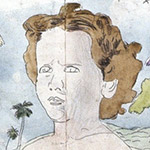
This week we look at the art world that exists outside of the gallery and museum structure. The three avenues we will explore are: Outsider Artists, Comix, and Graffiti. Often these art realms aren’t completely excluded from the gallery system the artists we will look at have also gotten a lot of gallery attention, and these artistic styles have greatly influenced artists working within the gallery system. Still, they are places where art exists often in fresh relief from the trends and pretensions of the main stream art world.
Outsider Artists
“Outsider art” is a term that is often used to describe artists who came to the arts outside of the usual channels of art school or training. It’s a term that is thrown around a lot, and sometimes artists with a solid academic background often capitalize on appearing to come from an outsider position. Of all the artists this week, the one that could 100% be considered an outsider is Henry Darger. He lived as a janitor in almost complete isolation in Chicago, and only on his death did anyone realize he had been making artworks at night. I’ve linked to a full length movie on him in the video section, but you don’t have to watch the whole thing — you can get a good idea of his life and work in the first ten of fifteen minutes.
Outsider artists are often accompanied by a reputation for mental instability. Of course this is often a accusation towards artists in general, but if you think about the Myth of Vincent Van Gogh, this is the stereotype often enforced by outsider artists. This is certainly the case with Daniel Johnston, who is equally well known in the music world as he is in the visual arts. I’ve linked to a trailer for the movie “The Devil and Daniel Johnston”, a fascinating movie that’s available on Netflix for those of you who are interested.
I’ve included two artists in here under the term “Outsider Architects” for lack of a better title — Austrian environmental activist, artists, and architect Hundertwasser, and Detroit native Tyree Guyton and his Heidelberg Project. We also will look briefly at the life and work of Rammelzee, an artist who was equally at home in the art, music and graffiti worlds of 1980′s New York.
Comix
Comix, with an ‘x’ is a way to distinguish the small press or self published realm of underground comix from main stream action hero comics put out by large companies like Marvel or DC Comics. Starting in the late 60′s, a scene of artists influenced by comic culture emerged, putting out experimental comics, often dealing with adult themes or a wry blend of humor and pornography. As these projects became more ambitious, the graphic novel was born — the novel length extension of the comic. One artist I want to introduce you to is Scott Mccloud, as much a comic historian as an artist himself. If we had more time to devote to this unit, I would have you all read Understanding Comics, his illustrated book on understanding the visual communication inherent to all comics. I will introduce you to two of the forefathers of the contemporary comix scene: Robert Crumb and Art Spiegelman. And we will also open a window into the world of many more comix authors: Ron Rege, Jim Woodring, Chris Ware, and Marjane Satrapi. Comix by nature translate very well into animation and film, and so many of the examples we will examine will be animations based on the work of these artists.
Graffiti
Finally we will take a quick look at graffiti, from the West Coast artists Margaret Kilgallen, Barry McGee, and miscreant Neck Face, to British artist Bansky.
The readings this week I’ve chosen to fill in two big gaps in this unit. The first is the lack of women in the section of Comix. I’m happy to be able to add Marjane Satrapi this year, who’s graphic novel Persephone has proven hugely popular and spawned an animated major motion picture. But often justifiably, comics are criticized as a male dominated art that frequently objectifies women. Less we go straight back to the sexism of the AbExers, I’ve included a short article outlining some women in the field.
Secondly, with the exception of Ramelzee, our graffiti artists are all white, in contrast to grafitti’s roots in the latino and African American youth cultures. Our second article is a British history students paper outlining the history of graffiti.
